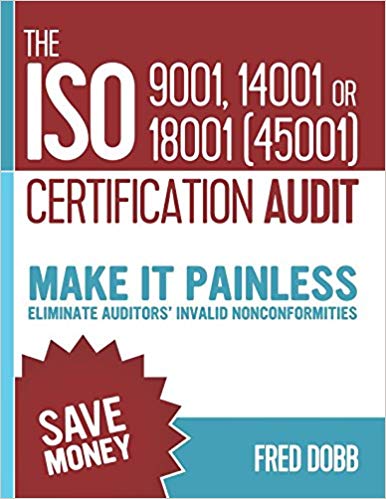3 Definitions T 38
Terms, definitions and books related to audits and occupational health and safety

The beginning of wisdom is the definition of terms. Socrates
Some terms and definitions currently used in this module:
Acceptable risk: risk reduced to a tolerable level
Accident: undesired event causing death or health and environmental damages
Audit client: everyone requesting an audit
Audit conclusions: outcome of an audit
Audit criteria: everything against which audit evidence is compared
Audit findings: every deviation from audit criteria
Auditee: everyone who is audited
Auditor: everyone who is trained to carry out audits
Competence: personal skills, knowledge and experiences
Corrective action: action to eliminate the causes of nonconformity or any other undesirable event and to prevent their recurrence
Customer: anyone who receives a product
Environment: space in which any organization functions
Hazard: situation that could lead to an incident
Incident: undesired event that could lead to health damages
Nonconformity: non-fulfillment of a specified requirement
Occupational health and safety (OH&S): everything that can influence the wellbeing of the personnel in a company
OH&SMS: Occupational Health and Safety Management System
Organization: a structure that satisfies a need
Product (or service): every result of a process or activity
Risk: plikelihood of occurrence of a threat or an opportunity
Safety: aptitude to avoid an undesired event
Stakeholder: person, group or company that can affect or be affected by an organization
Supplier: an entity that provides a product
Examples of stakeholders: investors, customers, suppliers, employees and social, public or political organizations
In the terminology of occupational health and safety management systems, do not confuse the following:
- anomaly, defect, dysfunction, failure, nonconformity, reject and waste
- an anomaly is a deviation from what is expected
- defect is the non-fulfillment of a requirement related to an intended use
- dysfunction is a degraded functionwhich can lead to a failure
- failure is when a function has become unfit
- nonconformity is the non-fulfillment of a requirement in production
- reject is a nonconforming product which will be destroyed
- waste is when there are added costs but no value
- accident and incident
- an accident is an unexpected serious event
- an incident is an event which can lead to an accident
- audit and inspect
- to audit is to check and to improve the OH&SMS
- to inspect is to verify the conformity of a process or product
- audit, auditee and auditor
- an audit is a process of evaluating and improving the OH&SMS
- an auditee is the one who is audited
- an auditor is the one who conducts the audit
- audit program and plan
- an audit program is the annual planning of the audits
- an audit plan is the description of the audit activities
- control and optimization
- control is meeting the objectives
- optimization is the search for the best possible results
- customer, supplier and subcontractor
- a customer receives a product
- a supplier provides a product
- a subcontractor provides a service or a product on which a specific work is done
- effectiveness and efficiency
- effectiveness is the level of achievement of planned results
- efficiency is the ratio between results and resources
- follow-up and review
- follow-up is the verification of the obtained results of an action
- review is the analysis of the effectiveness in achieving objectives
- hazard and risk:
- hazard is the state, the situation, the source which can lead to an accident
- risk is the measurement, the consequence of a hazard
- indicator and objective
- an indicator is the information on the difference between the achieved result and the pre-set objective
- an objective is a sought after commitment
- organization and enterprise, society, company
- organization is the term used in the standard ISO 9001 as the entity between the supplier and the customer
- enterprise, society and company are examples of organizations
- organizational chart and process map
- the organizational chart is the graphic display of departments and their links
- the process map is the graphic display of processes and their interaction
- procedure, process, product, activity and task
- a procedure is the description of how we should conform to the rules
- a process is how we satisfy the customer using people to achieve the objectives
- a product is the result of a process
- an activity is a set of tasks
- a task is a sequence of simple operations
Remark 1: each time you use the term "improvement opportunity" instead of nonconformity, malfunction or failure, the auditee will gain a little more confidence in you.
Remark 2: the use of ISO 19011, ISO 45001 and ISO 9000 definitions is recommended. The most important thing is to determine a common and unequivocal vocabulary for everyone in the company.
Remark 3: the customer can also be the user, the beneficiary, the initiator, the client, the prime contractor, the consumer.
Remark 4: ISO 19011 version 2018 uses the terms procedure (.gif) ), record (
), record ( ) and documented information together. We prefer the terms document, procedure and record.
) and documented information together. We prefer the terms document, procedure and record.
For other definitions, comments, explanations and interpretations that you don’t find in this module and annex 06, you can consult: .jpg)

- ISO Online Browsing platform (OBP)
- IEC Electropedia
- ISO 9000: Quality Management System - Fundamentals and vocabulary (2015)
- ISO 14050: Environmental Management - Vocabulary (2020)
.jpg) Books for further reading on internal audits:
Books for further reading on internal audits:
 David Hoyle, John Thompson, ISO 9000 Auditor Questions, Transition Support, 2001
David Hoyle, John Thompson, ISO 9000 Auditor Questions, Transition Support, 2001 J. P. Russel, The Internal Auditing Pocket Guide, ASQ Quality Press, 2002
J. P. Russel, The Internal Auditing Pocket Guide, ASQ Quality Press, 2002.jpg) Spencer Pickett, The Essential Handbook of Internal Auditing, John Wiley & Sons, 2005
Spencer Pickett, The Essential Handbook of Internal Auditing, John Wiley & Sons, 2005 Karen Welch, The Process Approach Audit Checklist for Manufacturing, ASQ Quality Press, 2005
Karen Welch, The Process Approach Audit Checklist for Manufacturing, ASQ Quality Press, 2005 J. P. Russel, The Process Auditing and Techniques Guide, ASQ Quality Press, 2010
J. P. Russel, The Process Auditing and Techniques Guide, ASQ Quality Press, 2010 Janet Smith, Auditing Beyond Compliance, ASQ Quality Press, 2012
Janet Smith, Auditing Beyond Compliance, ASQ Quality Press, 2012 Patrick Ambrose, ISO 9001:2008: Process Auditing Checklist, Amazon Digital Services, 2013
Patrick Ambrose, ISO 9001:2008: Process Auditing Checklist, Amazon Digital Services, 2013 Ron McKinnon, Risk-based, Management-led, Audit-driven, Safety Management Systems, CRC Press, 2016
Ron McKinnon, Risk-based, Management-led, Audit-driven, Safety Management Systems, CRC Press, 2016.jpg) Charles Reese, Occupational Health and Safety Management: A Practical Approach, CRC Press, 2017
Charles Reese, Occupational Health and Safety Management: A Practical Approach, CRC Press, 2017.jpg) Milton Dentch, The ISO 45001:2018 Implementation Handbook: Guidance on Building an Occupational Health and Safety Management System, ASQ Quality Press, 2018
Milton Dentch, The ISO 45001:2018 Implementation Handbook: Guidance on Building an Occupational Health and Safety Management System, ASQ Quality Press, 2018.jpg) Chris Ward, ISO 45001 Occupational Health and Safety Management System. Guide to Requirements: Non Technical Interpretation of ISO 45001 Requirements, Chris J Ward, 2018
Chris Ward, ISO 45001 Occupational Health and Safety Management System. Guide to Requirements: Non Technical Interpretation of ISO 45001 Requirements, Chris J Ward, 2018.jpg) Ramesh Lakhe, Kranti Dharkar, ISO 45001:2018 OCCUPATIONAL HEALTH & SAFETY MANAGEMENT SYSTEM (RRL), Independently published, 2018
Ramesh Lakhe, Kranti Dharkar, ISO 45001:2018 OCCUPATIONAL HEALTH & SAFETY MANAGEMENT SYSTEM (RRL), Independently published, 2018 Fred Dobb, The ISO 9001, 14001 or 18001(45001) certification audit: Make it painless, Eliminate auditors’ invalid nonconformities, Brodsworth & Woods, 2018
Fred Dobb, The ISO 9001, 14001 or 18001(45001) certification audit: Make it painless, Eliminate auditors’ invalid nonconformities, Brodsworth & Woods, 2018 Stephen Asbury, Health and Safety, Environment and Quality Audits: A Risk-based Approach, CRC Press, 2018
Stephen Asbury, Health and Safety, Environment and Quality Audits: A Risk-based Approach, CRC Press, 2018
 Minute of relaxation. Paganini's violin concert performed with facial expressions.
Minute of relaxation. Paganini's violin concert performed with facial expressions.
When I think of all the books still left for me to read, I am certain of further happiness. Jules Renard
